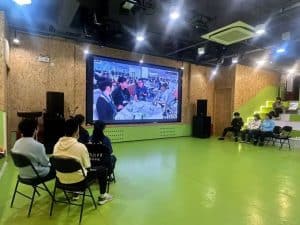The Conference of the Parties (COP) is often perceived as a high-stakes event dominated by world leaders and major international organizations, in which governments shape climate policies and global agreements. However, this perspective overlooks the critical contributions of grassroots organizations, local communities, and NGOs make in addressing climate change.
To explore this dynamic, China Development Brief invited Ms. Zhe Yao from Greenpeace, Zhong Zhao from Green Camal Bell, Ms. Ai Li from Tianjin Hexie Social Work and Ms. Ziqi Jia from Blue Ribbon Ocean Conservation Organization to discuss the role of smaller organizations in the COP process and how they can make a meaningful impact.

Understanding the Conference of the Parties (COP)
COP29, the annual meeting of the UNFCCC signatories, faces significant challenges in addressing climate change. Key concerns include uncertainties surrounding U.S. climate policy post-election and global economic pressures that could influence major economies’ commitments to climate action. A central focus of COP29 is climate finance, with developing nations advocating for an increase in annual funding from $100 billion to $1.3 trillion—an appeal met with resistance from developed countries. Additionally, divisions within the developing world further complicate discussions on funding allocation. Addressing these financial, political, and structural challenges is crucial for COP29’s success.
The Role of NGOs: Grassroots Power and Public Engagement
While COP negotiations center on high-level commitments and policy frameworks, tangible climate action extends far beyond government deliberations. Civil society organizations play a crucial role in bridging policy and practice, ensuring that commitments translate into real-world impact. China has a vibrant network of NGOs working on the front lines of climate action, leveraging grassroots power to drive public participation and promote sustainable solutions.
Green Camel Bell’s Climate Initiatives in Northwest China
Green Camel Bell, an environmental organization in China, has long been dedicated to climate and environmental work in the country’s northwest. Its primary focus is on rural communities, including farmers and herders, who contribute minimally to carbon emissions but are disproportionately affected by climate change.
For instance, farmers on the Loess Plateau are facing reduced rainfall and worsening droughts conditions, while herders on the Tibetan Plateau struggle with grassland degradation and increasingly extreme weather events such as snowstorms. In response, Green Camel Bell has implemented a range of adaptive measures. These include promoting ecological transformation by encouraging farmers to cultivate drought-resistant crops and supporting low-carbon initiatives such as providing energy-efficient stoves for herders and introducing clean photovoltaic energy solutions to promote sustainable livelihoods.

Green Camel Bell’s Objectives at COP29
At COP29, Green Camel Bell aims to achieve several key objectives, Firstly, it seeks to elevate grassroots voices on the global stage, ensuring that decision-makers consider the needs of vulnerable communities when crafting climate policies. Secondly, the organization hopes to learn from international best practices to enhance its local climate adaptation efforts. Thirdly, Green Camel Bell aspires to expand its network by engaging with institutions and businesses—particularly energy companies—to explore collaborative solutions to climate challenges.
The organization views environmental NGOs as crucial mediators, capable of facilitating dialogue between companies and communities to reduce conflicts, mitigate business risks, and foster mutual beneficial solutions. COP provides an invaluable platform to build consensus and drive cooperative climate initiatives.
Public Engagement: Tianjin Hexie Social Work and Blue-Ribbon Ocean Conservation
Similar to Green Camel Bell, Tianjin Hexie Social Work and Blue-Ribbon Ocean Conservation Association are dedicated to environmental protection and community sustainability. These organizations share a common goal of amplifying grassroots voices in climate discussions.
At COP29, both groups aim to gain insights from international experiences and exchange strategies for raising climate awareness among local communities. They also seek to inspire individuals to take meaningful climate action—no matter how small—that can collectively drive substantial environmental progress.

United for Change: A Collective Path to Sustainability
As COP29 unfolds, it is evident that diverse voices, especially those from grassroots organizations, are indispensable to effective climate action. While international negotiations and policy frameworks play a pivotal role in shaping climate governance, real progress often begins at the community level.
Climate action is not just solely the responsibility of governments, it requires a collective effort from all sectors of society. By amplifying grassroots voices and fostering cross-sector collaboration, COP29 presents a unique opportunity to unite diverse stakeholders in the fight against climate change and work towards a sustainable future for all.



